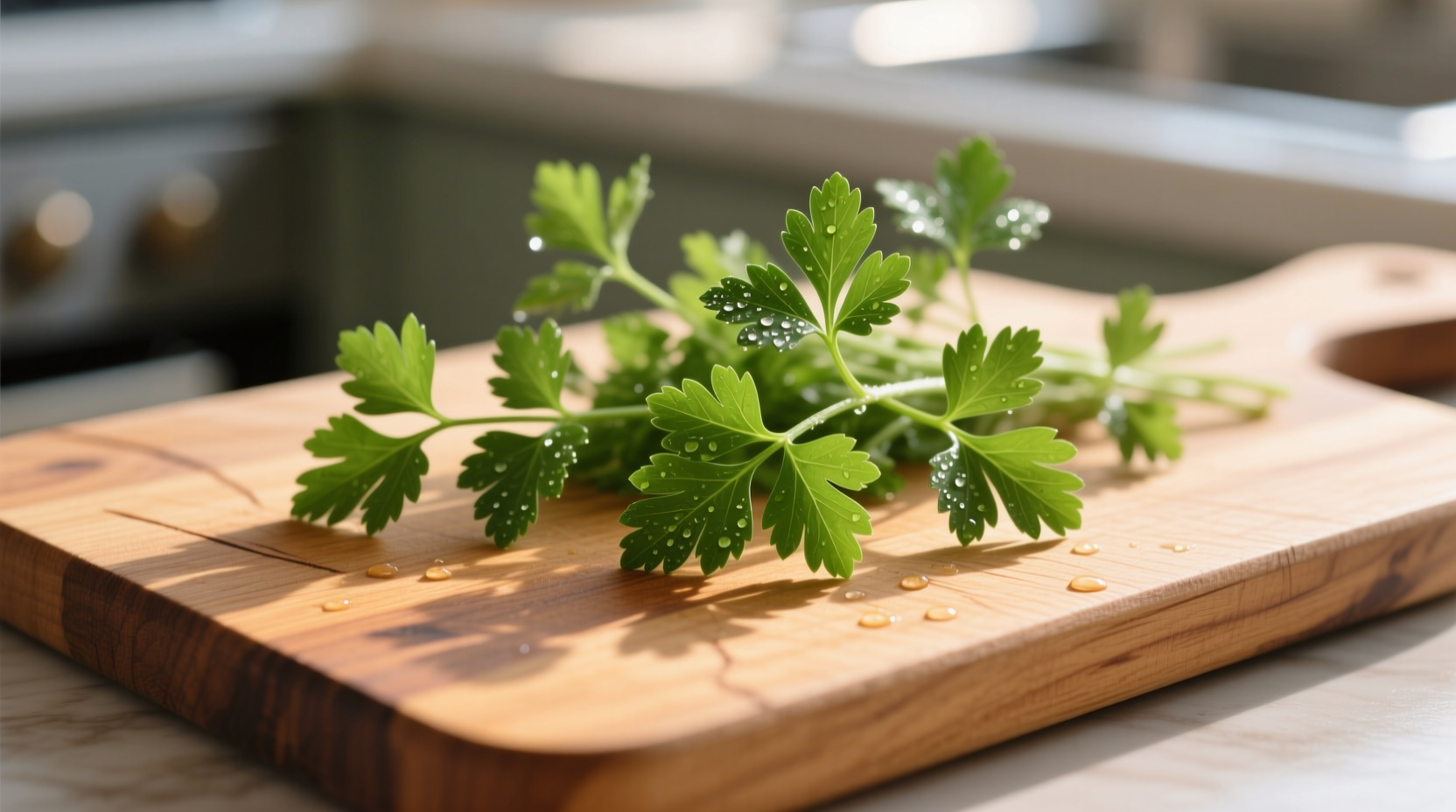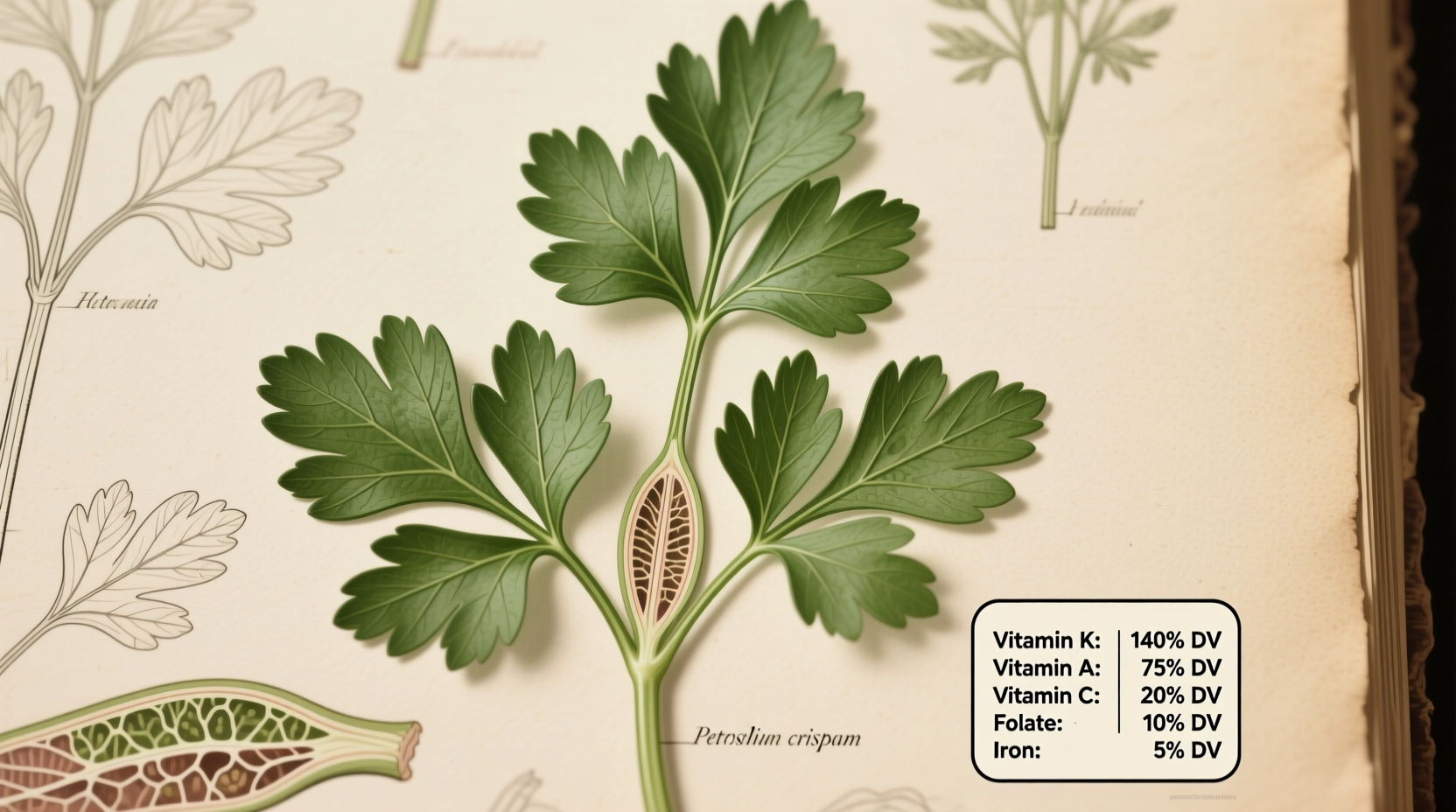Parsley delivers exceptional nutritional value in a low-calorie package, providing over 100% of your daily vitamin K needs in just one tablespoon. This vibrant herb contains significant amounts of vitamin C, vitamin A, folate, and iron, along with powerful antioxidants that support overall health. Understanding parsley's complete nutrient profile helps you maximize its health benefits in everyday cooking.
The Complete Nutritional Breakdown of Parsley
When evaluating parsley nutrient content, it's essential to examine both raw and cooked forms. According to USDA FoodData Central, one-quarter cup (15g) of fresh, chopped parsley contains:
| Nutrient | Amount per 15g | % Daily Value |
|---|---|---|
| Calories | 5 | 0% |
| Vitamin K | 246 mcg | 205% |
| Vitamin C | 13 mg | 14% |
| Vitamin A | 420 mcg | 47% |
| Folate | 31 mcg | 8% |
| Iron | 0.7 mg | 4% |
| Calcium | 19 mg | 1% |
This impressive nutritional profile makes parsley one of the most nutrient-dense herbs available. The vitamin K content particularly stands out, as it plays a crucial role in blood clotting and bone health. Research from the National Institutes of Health confirms that adequate vitamin K intake supports proper bone mineralization and cardiovascular health.
How Parsley Compares to Other Common Herbs
When analyzing fresh parsley nutritional value against similar herbs, parsley consistently outperforms in several key areas. This comparison uses equivalent serving sizes (15g) to provide accurate perspective:
| Nutrient | Parsley | Cilantro | Basil | Dill |
|---|---|---|---|---|
| Vitamin K (mcg) | 246 | 31 | 54 | 39 |
| Vitamin C (mg) | 13 | 5 | 4 | 3 |
| Vitamin A (mcg) | 420 | 204 | 100 | 100 |
| Folate (mcg) | 31 | 8 | 9 | 8 |
Source: USDA FoodData Central (accessed 2023)
As the table demonstrates, parsley contains significantly higher levels of vitamin K and vitamin A compared to other common culinary herbs. This makes it particularly valuable for supporting bone health and vision. The nutritional composition of parsley per 100g shows even more dramatic advantages when considering larger quantities.
Practical Health Benefits of Parsley's Nutrient Profile
Understanding the nutritional facts about parsley becomes more valuable when you know how these nutrients benefit your body. The high vitamin K content supports proper blood clotting and bone metabolism, while the substantial vitamin C provides antioxidant protection and boosts immune function.
Recent research published in the Journal of Agricultural and Food Chemistry identified apigenin and luteolin as key antioxidants in parsley. These compounds demonstrate anti-inflammatory properties that may help reduce chronic disease risk. Unlike many vegetables, parsley maintains much of its nutritional value even when cooked, though some vitamin C is lost with heat exposure.

Maximizing Nutritional Benefits in Your Diet
To get the most from parsley's nutritional content in cooking, consider these evidence-based strategies:
- Add fresh parsley at the end of cooking to preserve heat-sensitive nutrients like vitamin C
- Pair parsley with healthy fats (like olive oil) to enhance absorption of fat-soluble vitamins A, E, and K
- Use both leaves and stems - the stems contain concentrated nutrients
- Store parsley properly by placing stems in water and covering loosely with a plastic bag
- Freeze excess parsley in olive oil cubes for future use while preserving nutrients
When evaluating parsley nutrient density compared to other greens, it's important to recognize context boundaries. While parsley excels in certain nutrients, it shouldn't replace leafy greens like spinach or kale in your diet. Instead, view it as a complementary nutrient source that adds variety to your phytonutrient intake.
Common Misconceptions About Parsley Nutrition
Several myths persist about parsley's nutritional value. Contrary to popular belief, parsley doesn't contain significant protein or fiber. Its primary value comes from micronutrients and phytochemicals. Additionally, while parsley tea is popular, most nutrients are better absorbed when consumed with food rather than as a tea.
Some sources exaggerate parsley's diuretic effects. While it does contain apiol which may have mild diuretic properties, these effects are modest compared to medical diuretics. The complete nutritional profile of fresh parsley shows it's primarily valuable for its vitamin and antioxidant content rather than dramatic physiological effects.
Practical Applications for Everyday Health
Incorporating parsley into your daily routine doesn't require dramatic changes. Adding just two tablespoons to your meals provides substantial nutritional benefits without altering flavors significantly. Try these simple approaches:
- Blend into morning smoothies (the chlorophyll content boosts nutrient density)
- Use as a base for herb sauces like chimichurri or gremolata
- Add to soups and stews during the last few minutes of cooking
- Mix with other herbs for compound butter
- Create a parsley pesto as an alternative to traditional basil pesto
For those monitoring vitamin K intake due to blood-thinning medications, consult with your healthcare provider about appropriate parsley consumption. The vitamin K content in parsley per serving can affect medication efficacy, making consistent intake important for these individuals.
Frequently Asked Questions
How much parsley do I need to meet my daily vitamin K requirement?
Just one tablespoon (5g) of fresh parsley provides approximately 62% of the recommended daily intake of vitamin K for adults. A quarter cup (15g) delivers over 200% of your daily needs. This makes parsley one of the most concentrated natural sources of vitamin K available.
Does cooking parsley destroy its nutritional value?
Cooking affects different nutrients in parsley to varying degrees. Vitamin K and vitamin A are relatively stable during cooking, while vitamin C decreases by about 25-30% with light cooking. To maximize nutritional benefits, add parsley during the last few minutes of cooking. Steaming preserves more nutrients than boiling.
Is dried parsley as nutritious as fresh parsley?
Dried parsley retains some nutrients but loses significant amounts of vitamin C and certain volatile compounds during the drying process. However, it maintains much of its vitamin K content. One teaspoon of dried parsley equals approximately one tablespoon of fresh, but for maximum nutritional benefit, fresh parsley is preferable when available.
Can parsley help with iron absorption?
Yes, parsley contains both iron and vitamin C, which enhances non-heme iron absorption from plant sources. The vitamin C in parsley can increase iron absorption from other foods in your meal by up to six times. This makes parsley particularly valuable in vegetarian and vegan diets where iron absorption can be challenging.
What's the difference in nutrient content between curly and flat-leaf parsley?
Flat-leaf (Italian) parsley generally contains slightly higher concentrations of nutrients than curly parsley. Studies show flat-leaf varieties have approximately 15-20% more vitamin C and antioxidants. However, both types provide excellent nutritional benefits, and personal preference for flavor and texture should guide your choice.











 浙公网安备
33010002000092号
浙公网安备
33010002000092号 浙B2-20120091-4
浙B2-20120091-4